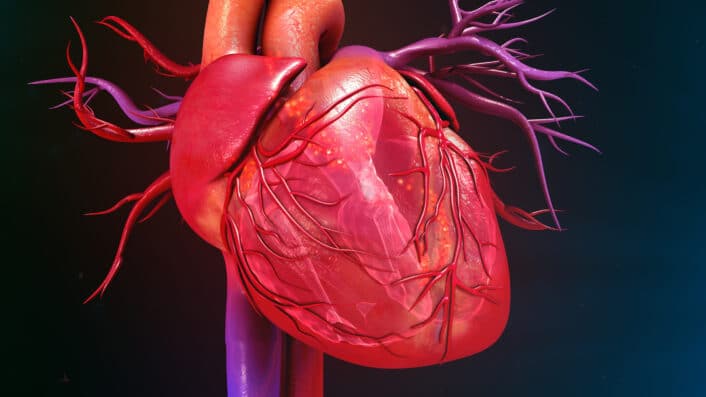

Disclaimer: This article is for informational purposes only and is not intended for diagnostic use. LifeDNA does not provide diagnostic reports on any traits discussed. Genetics is just one piece of the puzzle; please consult a healthcare professional for comprehensive guidance on any health condition.
Marfan Syndrome is a genetic condition that affects the body’s connective tissue. Our connective tissue provides support, strength, and elasticity to other body structures. Marfan’s syndrome can impact your skeletal and cardiovascular systems as well as your eyes. Individuals with Marfan Syndrome often have distinctive physical features such as unusually long arms, legs, and fingers, a tall and slender build, and a curved spine.
The cardiovascular complications are the most serious aspect of Marfan syndrome, particularly a weakened aorta. The aorta is a large blood vessel that carries blood from the heart to the rest of the body. Without proper management, a weakened aorta can lead to life-threatening conditions such as aortic dissection or rupture. Marfan Syndrome affects about 1 in 5,000 people regardless of race, ethnicity, or gender. Early diagnosis and appropriate treatment can help manage the symptoms and prevent complications, significantly improving the quality of life for those with the condition.
Marfan Syndrome is caused by mutations in the FBN1 gene, which encodes a protein called fibrillin-1. Fibrillin-1 is a crucial component of connective tissue and contributes to the formation of elastic fibers, which provide elasticity and strength to tissues and organs.
The FBN1 gene mutations lead to the production of abnormal fibrillin-1 or insufficient amounts of the protein, disrupting the structure and function of connective tissues throughout the body. Interestingly the genetic variants of this gene are also related to other traits.
According to a 2020 study with Peruvian participants, specific missense variant in the FBN1 gene (E1297G) is linked to shorter stature, with each copy of the minor allele that is present in 4.7% of Peruvian individuals, decreasing height by 2.2 cm, and by 4.4 cm in homozygous individuals. This is the largest known effect for a common height-associated variant. Although common in Peru, this variation is absent in European populations. In a 2020 article, The Broad Institute labeled this as the most powerful genetic variant associated with height, discovered to date. Interestingly individuals affected by Marfan’s syndrome, who typically dont have the E1297G mutation, are characteristically much taller than the rest of their family members.
Variations in the FBN1 gene have also been implicated in eye health. A 2020 GWAS identified FBN1 among other genes like BMP7, COL6A1, and THBS4 that play significant roles in the organization of the structural support that surround cells (a.k.a extracellular matrix). FBN1’s role in the structural integrity of this matrix makes it crucial for both overall growth and the specific development of connective tissues. The study underscores the gene’s importance by linking it with genetic variants that influence eye size and development, particularly corneal curvature and axial length, which are critical for maintaining proper vision.
You may also like: The Genetics of Visual Acuity
A 2011 meta-analysis suggested a significant link between the SNP rs140598 in the FBN1 gene and essential hypertension. A more recent association study conducted in the Chinese Han population uncovered several other potential markers connecting FBN1 gene and blood pressure. Researchers examined four tagging SNPs in 2,012 hypertension cases and 2,116 controls. Significant associations were found between hypertension and SNPs rs17361868, rs668842, and rs11635140, with variations observed across different factors such as age, gender, smoking, and drinking status.
Marfan Syndrome is inherited in an autosomal dominant pattern. This means that one copy of the mutated FBN1 gene, inherited from one affected parent, is enough to cause the disorder. Each child of an affected parent has a 50% chance of inheriting the condition. The disorder does not skip generations and can be equally transmitted by either parent, regardless of gender.
While most cases of Marfan Syndrome are inherited from a parent who has the condition, approximately 25% of cases result from a spontaneous mutation in the FBN1 gene, with no previous family history. These spontaneous mutations occur randomly and are not inherited from the parents. Genetic counseling is recommended for individuals with Marfan Syndrome who are considering starting a family, as it provides valuable information on the risks of passing the condition to offspring and the implications for family planning.
Diagnosing Marfan Syndrome involves a comprehensive approach that includes a detailed medical history, physical examination, and a series of specialized tests. Physicians look for characteristic features of Marfan Syndrome such as skeletal abnormalities (e.g., long limbs, scoliosis), cardiovascular issues (e.g., enlargement of the aorta), and eye problems (e.g., lens dislocation). Imaging tests like echocardiograms, which visualize the heart and aorta, are crucial in identifying potential cardiovascular complications.
Genetic testing can confirm the diagnosis by identifying mutations in the FBN1 gene. However, a clinical diagnosis is often made based on the presence of a combination of symptoms and family history, even if genetic testing is inconclusive. The Ghent criteria, a diagnostic tool, helps clinicians evaluate these signs and symptoms systematically. Early and accurate diagnosis is essential for initiating appropriate management strategies to prevent severe complications associated with the condition.
Managing Marfan Syndrome involves regular monitoring and a multidisciplinary approach to address the various systems affected by the disorder. Cardiovascular management is crucial, focusing on regular echocardiograms to monitor the size and function of the aorta.
Medications such as beta-blockers or angiotensin receptor blockers are commonly prescribed to reduce stress on the aorta and slow its enlargement. In severe cases, surgical intervention may be necessary to repair or replace the aorta. Orthopedic interventions, including physical therapy and sometimes surgery, help manage skeletal issues like scoliosis.
Regular eye examinations are important to monitor and correct lens dislocation or other vision problems. Lifestyle adjustments, such as avoiding contact sports and heavy lifting, help reduce the risk of aortic complications. Genetic counseling provides support and information for affected individuals and their families. With vigilant management, many people with Marfan Syndrome can lead active, productive lives while minimizing the risk of serious complications.


